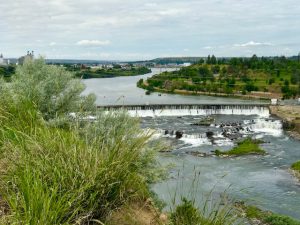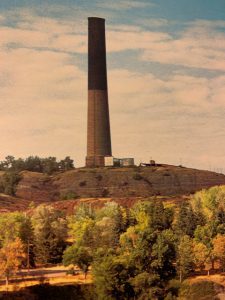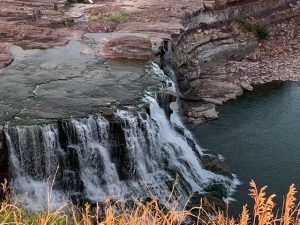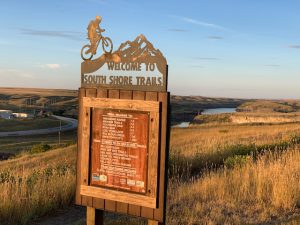Waterfalls, Freshwater Springs and a Smokestack
Posted August 14, 2019

Overlooking Black Eagle Falls
The five waterfalls of the Mighty Missouri River are the liquids that gave the town known as Great Falls its name. The Missouri River drops a total of 612 feet in ten miles as it tumbles over five waterfalls. About 187 feet of that drop is the plunge from the series of waterfalls, and the remaining 425 feet comes from the descent of the riverbed.
Black Eagle Falls are the uppermost falls and they are best viewed from a overlook area on the south side of the river along River Drive. These falls were named after Meriwether Lewis saw an eagle’s nest on an island near the multiple cataracts. This was 1805 and Lewis was no doubt the first white man to see them. There is a hydroelectric dam on the falls today but when the water is raging it’s a spectacular sight to see.
If you were at Black Eagle Falls before 1982 you would have seen a massive smokestack looming on a hill

Archival image of the Big Stack in Great Falls
on the north side of the Missouri River. Copper and silver were smelted there until 1918 and then the Anaconda Company converted to an electrolytic copper and zinc refinery. That big smokestack had deteriorated and it either needed large amounts of money to repair it even though it wasn’t being used, or it would be be blown up.
Two sides – one in favor of fundraising to restore the stack – and one seeking demolition – each mounted campaigns. The fundraising group fell short of their monetary goal and the stack was blown up in 1982. Six hundred pounds of explosives failed to topple the entire stack on the first try and those in favor of restoring it were elated. By evening the demolition crew had leveled the remaining portions of large part of Great Falls’ history. I was there and watched the brick and mortar crumble.
The Anaconda Company blamed federal air quality regulations for the initial shutdown of their operations. The community didn’t believe it would happen. They were wrong.
The 74 year old smokestack had become a symbol of Great Falls and job security for many. No matter which side you were on, blow it up or preserve it, the landscape changed and so did the future of Great Falls.

Giant Springs bubbling up in the Missouri River
As you follow the Missouri downstream, the next major item to view is Giant Springs, not a waterfall, but unique in its own right. The Lewis & Clark Expedition came upon this spring, also in 1805, and it is one of the largest freshwater springs in the country. If you float down the Missouri near the springs you can feel the water temperature change when you are near the water bubbling up from the spring. The water temperature is a constant 54 degrees all year long. It’s refreshing in the summer and the mist and humidity make some amazing frost in the winter. Giant Springs State Park is where you’ll find the springs and there are walking trails, great bird watching, picnic areas and playground equipment for kids. A fish hatchery is also there and an indoor educational exhibit about fish in the Missouri River is free to visit. The water in Giant Springs flows from the Little Belt Mountains nearly 60 miles from the location where the springs bubble up.

One of several cataracts at Rainbow Falls
The next set of waterfalls is Colter Falls (sometimes spelled Coulter) which are submerged and you may have guessed that they were named for fur trapper and frontiersman John Colter. Colter was also a member of the Lewis & Clark Expedition. At a mere 6 feet 7 inches, Colter is the smallest set of waterfalls on this stretch of the Missouri River.
Next in line is Rainbow Falls, the second tallest of the five waterfalls at 44 feet. William Clark named these falls Beautiful Cascade but Rainbow Falls became the permanent name. Today a hydroelectric dam crosses the top of Rainbow Falls.
Two viewing areas here give you a great perspective on the power and force of the water. Rugged riverbanks line both sides of the river. Interpretive panels are in both the upper and lower viewing areas.
The overlooks at Rainbow Falls are heavily used – first by folks seeking to view the falls but next by

Entrance to the South Shore Trails
bicycle riders. The Rivers Edge Trail, approximately 60 miles long, is a mecca for hikers and bikers as it follows the Missouri River through Great Falls and beyond. Access to the South Shore trails, the single track portion, is adjacent to the overlook. Annual bike races start and end here and the views as you bike are endless. There are steep dropoffs to the river though so keep your eyes on the trail!
Crooked Falls, sometimes called Horseshoe Falls because of their shape, are next. The Missouri River takes a sharp bend here and forms a horseshoe. At a 19 foot drop Crooked Falls aren’t very dramatic but the riverbanks are wide open here and you can see vast landscapes.
The final falls, named The Great Falls by Meriwether Lewis, are by far the largest and most dramatic. With an 87 foot drop they are a photo op waiting to happen. The best viewing of The Great Falls is by taking the Ryan Dam road 4 miles north of town on US Hwy 87 and traveling about 8 miles past wheat fields. All of a sudden you drop down to the north shore of the Missouri.

The Great Falls of the Missouri
Ryan Dam spans the top of The Great Falls. You can view these falls year round but summer views are best. An island, Ryan Dam picnic island, is accessed by a short suspension/swaying bridge and when you cross that you can get much closer to the falls. Open from Mother’s Day through Labor Day weekend, the island is a popular picnic area, viewing area and even a wedding area. A clubhouse can be rented for large parties and the island has picnic shelters and barbecues that can be used.
All of the waterfalls are on a stretch of the Missouri River that is only 10 miles. You can only imagine what the Lewis & Clark Expedition thought when they portaged one waterfall, only to run in to the rest. It took over a month for them to travel 10 miles.
Bring your camera, capture that tumbling water in photos, and learn some history.
Recent Posts

March 15, 2023
The open road ahead had me filled with a mixture of nostalgia and excitement. Having grown up in Montana, it…
Read More
February 16, 2024
If Central Montana is the Heart of the Big Sky, then Lewistown would be one of its main heartbeats. Geographically…
Read More
May 30, 2023
Silence the noise, escape the hurry, and feel light years away in the dark skies of Central Montana – where…
Read More









